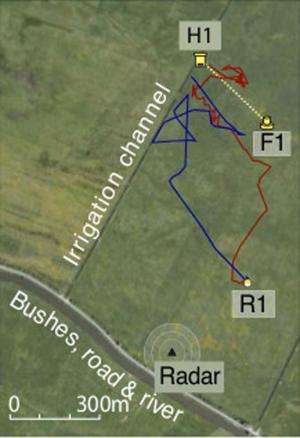June 3, 2014 report
Research shows bees might create cognitive maps

(Phys.org) —How do bees find their way home? Until now, scientists thought bees navigated by calculating their position relative to that of the sun. Randolf Menzel of the Free University of Berlin and colleagues tested this hypothesis by disrupting bees' circadian clocks. They found bees were able to navigate successfully, despite being unable to use the sun as an aid, suggesting that bees create cognitive maps. The study appears in the Proceedings of the National Academy of Sciences.
To get to the store and back without getting lost, you use a cognitive map. Mammals, and possibly all vertebrates, create cognitive maps, which they update constantly, by remembering landmarks and storing information about their locations in their brains. A cognitive map allows you to point toward your home, even when you're in a windowless room.
Creating a cognitive map is a complex mental task. Scientists believe we form cognitive maps in a part of the brain known as the hippocampus. Bees have tiny brains and nothing resembling a hippocampus. Therefore, scientists thought they must not use cognitive maps and depend on the sun to guide them instead.
To test this belief, Menzel's team tried tampering with bees' sense of time, so the bees wouldn't be able to use the sun to calculate their position. The researchers anesthetized a group of bees, leaving them unconscious for six hours. This meant when the bees awoke, they didn't know what time it was and the sun appeared to be in the wrong position in the sky.
The researchers then released the bees in an unfamiliar field and radar tracked them to see if they would be able to find their way back to the hive. If the bees relied solely on the sun to navigate, they would be lost. The bees did start out by flying in the wrong direction, but they soon turned around, getting back to the hive as quickly as a control group of bees the team hadn't anesthetized.
This meant the bees used something other than the sun to get them home. The researchers think this is probably a cognitive map. They believe that in addition to using the sun as a compass, bees create a mental map of the terrain they fly over by looking for landmarks, such as rows of bushes.
Menzel and his team say scientists studying the mammalian brain should bear in mind that bees might be able to create complex mental maps despite having brains many times smaller than the hippocampus of a rat.
More information: Way-finding in displaced clock-shifted bees proves bees use a cognitive map, James F. Cheeseman, PNAS, DOI: 10.1073/pnas.1408039111
Abstract
Mammals navigate by means of a metric cognitive map. Insects, most notably bees and ants, are also impressive navigators. The question whether they, too, have a metric cognitive map is important to cognitive science and neuroscience. Experimentally captured and displaced bees often depart from the release site in the compass direction they were bent on before their capture, even though this no longer heads them toward their goal. When they discover their error, however, the bees set off more or less directly toward their goal. This ability to orient toward a goal from an arbitrary point in the familiar environment is evidence that they have an integrated metric map of the experienced environment. We report a test of an alternative hypothesis, which is that all the bees have in memory is a collection of snapshots that enable them to recognize different landmarks and, associated with each such snapshot, a sun-compass–referenced home vector derived from dead reckoning done before and after previous visits to the landmark. We show that a large shift in the sun-compass rapidly induced by general anesthesia does not alter the accuracy or speed of the homeward-oriented flight made after the bees discover the error in their initial postrelease flight. This result rules out the sun-referenced home-vector hypothesis, further strengthening the now extensive evidence for a metric cognitive map in bees.
Journal information: Proceedings of the National Academy of Sciences
© 2014 Phys.org













